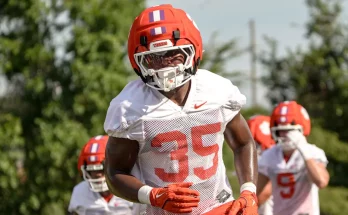In an announcement that has sent shockwaves through the Texas Longhorns football community, the University of Texas has revealed plans to erect a statue at Darrell K Royal-Texas Memorial Stadium in honor of one of the greatest players to ever wear the burnt orange: Earl Campbell. The statue will serve as a tribute to Campbell’s extraordinary legacy, which has not only shaped Texas Longhorns football but also influenced the entire NFL and the sport of football at large.
A Legacy of Excellence
Earl Campbell’s name is synonymous with power, speed, and toughness, making him one of the most beloved figures in the history of Texas football. His journey from a small town in Texas to becoming a college football legend and a Hall of Famer in the NFL is a story of perseverance, hard work, and incredible talent.
Campbell played for the Texas Longhorns from 1974 to 1977, where he quickly became a household name. During his time at Texas, Campbell transformed from a highly-touted recruit into one of the most dominant forces in college football. His exceptional running ability and strength, paired with his hard-nosed style of play, made him nearly unstoppable on the field.
The 1977 season stands as a pinnacle moment in Campbell’s career at Texas. He led the Longhorns to a Southwest Conference title and helped secure a victory in the 1978 Cotton Bowl Classic, earning the game’s MVP honors. His electrifying runs, marked by his ability to break tackles and steamroll defenders, became a hallmark of his playing style.
College Football’s “Typhoon”
Campbell’s college career was nothing short of spectacular. He amassed over 4,000 rushing yards during his time at Texas, and his name still holds a place among the program’s all-time greats. His remarkable ability to churn out yards on the ground made him a dynamic force for Texas, and his powerful, physical running style earned him the nickname “The Tyler Rose.”
Campbell’s impressive performance in college culminated in multiple accolades, most notably winning the prestigious Heisman Trophy in 1977. He became the first Longhorn to ever win the Heisman, a recognition that solidified his place in college football history. His Heisman victory was symbolic not only of his personal excellence but also of the Texas Longhorns’ dominance during the 1970s.
His time at Texas, which included being a unanimous All-American and setting numerous school records, is still revered in Austin. Even after all these years, Campbell’s legacy continues to be a benchmark for running backs to measure themselves against, and his impact is still felt within the university and the city.
A Monumental Achievement in the NFL
After a storied college career, Campbell made the jump to the NFL, where his greatness would continue to be on display. In 1978, he was selected as the first overall pick in the NFL Draft by the Houston Oilers (now the Tennessee Titans). Campbell’s transition from college to the pros was seamless, as he became an instant superstar in the NFL.
Over the course of his career, Campbell established himself as one of the most dominant running backs in NFL history. In his first season with the Oilers, he rushed for over 1,450 yards, earning NFL Offensive Rookie of the Year honors. But it was in the subsequent years that Campbell truly made his mark, rushing for over 1,800 yards and leading the Oilers to the playoffs in 1979.
Campbell’s signature style – running over defenders with ferocity, combined with a rare blend of speed and strength – made him one of the most feared players in the NFL. He led the league in rushing yards three times during his career and was selected to five Pro Bowls. But perhaps his most defining achievement came in 1979 when he was named the NFL MVP, a testament to his extraordinary skill and leadership.
After spending the bulk of his career with the Oilers, Campbell concluded his playing days with the New Orleans Saints, leaving behind a legacy that is still celebrated in Tennessee, Houston, and across the NFL.
The Statue’s Significance
The decision to honor Earl Campbell with a statue at Darrell K Royal-Texas Memorial Stadium speaks volumes about the profound impact he has had on both the University of Texas and the world of football as a whole. For many, Campbell represents the epitome of what it means to be a Texas Longhorn: an individual who embodies the grit, determination, and excellence that the program has come to symbolize.
The statue will not only be a permanent reminder of Campbell’s achievements on the field but also a tribute to his contributions off the field. Known for his humility and commitment to giving back to his community, Campbell’s legacy extends beyond his on-field accomplishments. He has served as a mentor to many athletes and has been actively involved in various charitable endeavors throughout his life.
The timing of the announcement also carries special significance. As the Texas Longhorns football program continues to rise and the team moves to the SEC, this statue is a symbolic gesture, reinforcing the program’s rich history and commitment to honoring its legends. It’s also a clear statement that Campbell’s contributions to the sport and his place in the university’s legacy are timeless.
The Unveiling Ceremony
The official unveiling of the Earl Campbell statue is expected to take place during the upcoming football season, with a ceremony that will be attended by former teammates, coaches, and fans who have witnessed Campbell’s greatness throughout the years. The statue will be placed prominently at Darrell K Royal-Texas Memorial Stadium, where it will serve as a focal point for future generations of Longhorns to admire and celebrate.
It is anticipated that the unveiling will be accompanied by tributes from former players, coaches, and dignitaries who have been impacted by Campbell’s career. Texas athletic director Chris Del Conte shared his excitement about the decision, saying, “Earl Campbell is not just a legend at the University of Texas, he is an icon in the world of football. He set the standard for what it means to be great, and this statue will ensure that his legacy lives on forever in Austin.”
Reflecting on the Impact
For many former players and coaches, Campbell’s impact extends far beyond his time at Texas. Longhorns head coach Steve Sarkisian recently praised Campbell’s influence, stating, “Earl set the bar for what it means to be a Texas Longhorn. He’s a guy who played the game with passion and heart, and those qualities are what we try to instill in our players today. Earl’s legacy will continue to inspire the next generation of Longhorns.”
For Campbell himself, the honor of having a statue erected in his name is a humbling recognition of a lifetime of hard work and dedication. In a statement, he expressed his gratitude, saying, “To be honored in this way by the University of Texas and to have a statue placed at Darrell K Royal-Texas Memorial Stadium is truly overwhelming. I am proud of what we accomplished during my time at Texas, and I am forever grateful to the coaches, teammates, and fans who supported me along the way.”
Conclusion
Earl Campbell’s impact on Texas Longhorns football, the NFL, and the sport of football as a whole cannot be overstated. His electrifying runs, unmatched toughness, and commitment to excellence make him a true icon. The decision to erect a statue in his honor at Darrell K Royal-Texas Memorial Stadium is not just a celebration of his individual achievements but also a recognition of his place in the larger history of the sport.
For generations to come, the Earl Campbell statue will serve as a powerful reminder of the greatness that once graced the Texas Longhorns football program and the lasting impact that one player can have on a university, a community, and a sport.



